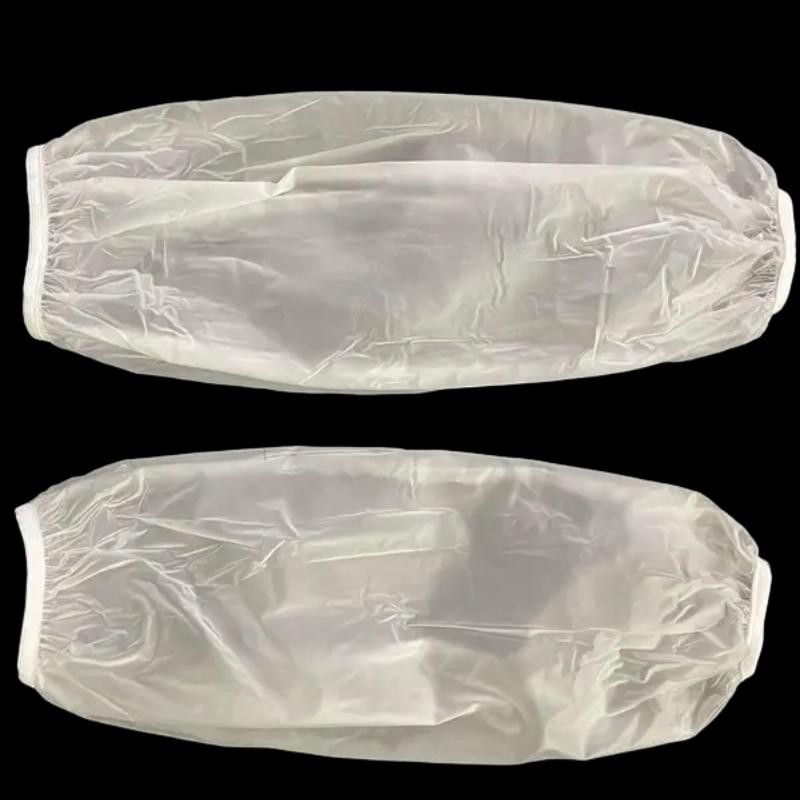Oct . 18, 2025 13:40 Back to list
PVC/PEVA Sleeves: Waterproof, Chemical-Resistant, Durable
Field Notes: The Quiet Rise of Practical Arm Protection
If you spend time on factory floors or in wet labs, you notice subtle shifts before they show up in market stats. Lately, I’ve seen more buyers swapping disposable sleeves for sturdier, wipe-clean options. That’s where PVC/PEVA Sleeves keep popping up—quietly, reliably, and, to be honest, saving budgets in places no one expected.
What are we really talking about? Flexible film sleeves made from PVC or PEVA with sealed seams and elastic cuffs. They shrug off splash, oils, weak acids/alkalis, and the day-to-day scuffs of production. Hospitals like them for quick sanitation. Beauty salons for color and chemical splash. And factories—well, they like anything that just keeps working.

Industry snapshot
Two currents drive demand: stricter hygiene audits (food/pharma) and sustainability pressure to reduce single-use waste. Surprisingly, some plants report fewer changeovers with PVC/PEVA Sleeves than with thin disposables—less tearing, less stock loss. And yes, PEVA’s “non-chlorinated” story plays well with procurement teams aiming for greener signals.
Typical spec (real-world, not brochure-only)
| Material | PVC (phthalate-reduced options) or PEVA |
| Thickness | ≈0.12–0.25 mm (usage-dependent; real-world use may vary) |
| Length | ≈36–46 cm; custom on request |
| Seams | HF welded/heat sealed; leak-tested |
| Cuffs | Elastic or knitted; optional double elastic |
| Temperature range | ≈-10°C to +50°C (PVC), ≈-20°C to +50°C (PEVA) |
| Certs/Compliance | REACH, RoHS; supports PPE Reg. (EU) 2016/425 Category I use-cases |
| Service life | Around 3–12 months in light-duty; 1–6 months heavy splash duty |
How they’re made (shop-floor version)
- Material prep: PVC compounding or PEVA film extrusion.
- Cutting: die-cut panels with grain alignment for tear resistance.
- Sealing: high-frequency welding; seam width ≈8–12 mm.
- Cuffs: elastic/knit attachment; optional ultrasonic tacking.
- QC and testing: see below; then cleaning, folding, bagging, carton.
- Origin: No. 12, Shuangtong Road, Dahe Town, Luquan District, Shijiazhuang City, Hebei Province.
Testing and indicative data
Numbers that matter in audits, with lab methods buyers recognize:
- Tensile strength (ASTM D882): PVC ≈18–28 MPa; PEVA ≈12–20 MPa.
- Tear (ASTM D1004): ≈60–120 N (material and thickness dependent).
- Hydrostatic/penetration (ISO 16603/16604): pass synthetic blood at low pressures for splash protection tiers.
- Abrasion (ASTM D4060): Taber loss ≈80–140 mg/1,000 cycles (CS-10, 1 kg).
Note: for infectious risk, pair PVC/PEVA Sleeves with appropriate gowns and glove interfaces per EN 14126 and facility SOPs.
Where they fit
Factories (machining oil splash), food processing (washdown lines), pharma & labs (cleanable sleeves over garments), hospitals (non-sterile splash tasks), salons (dye, bleach). Many customers say the wipe-down between shifts is “the small win that adds up.”
Customization
Color-coding by zone, logo print, matte/embossed finishes for grip, anti-fog coating near wrist, cuff swaps, and packaging by pair or bulk—simple changes that make supervisors’ lives easier.
Vendor comparison (quick glance)
| Vendor | Material Options | Certifications | MOQ | Lead Time |
|---|---|---|---|---|
| Helee Garment (Hebei) | PVC, PEVA; custom thickness | REACH, RoHS; supports ISO sampling | ≈1,000 pairs | ≈15–25 days |
| Coastal PPE | PVC standard | RoHS | ≈2,000 pairs | ≈25–30 days |
| LabShield Asia | PEVA, recycled content option | REACH | ≈1,500 pairs | ≈20–35 days |
Two quick cases
- Pharma plant, wet granulation: switching to PVC/PEVA Sleeves cut sleeve changeovers by ≈38% and improved audit readiness (fewer seam failures).
- Seafood processor: PEVA sleeves reduced odor retention and simplified end-of-shift sanitation; supervisors reported better cuff integrity through multiple washdowns.
Final thought: these sleeves won’t solve every PPE problem, but they’re a dependable, cleanable layer where splash and abrasion meet. Simple, but it works.
Authoritative references
- ASTM D882 – Standard Test Method for Tensile Properties of Thin Plastic Sheeting.
- ISO 16603/16604 – Clothing for protection against contact with blood and body fluids.
- EN 14126:2003 – Performance requirements and tests for protective clothing against infective agents.
- Regulation (EU) 2016/425 – Personal Protective Equipment (PPE).
-
Efficient Shroud Kit Pack Factory Solutions for Global Supply Chains
NewsNov.24,2025
-
Leading Shroud Kit Pack Exporter Solutions – Durable & Sustainable Packaging for Global Trade
NewsNov.23,2025
-
Reliable Shroud Kit Pack Manufacturer for Global Packaging Solutions
NewsNov.23,2025
-
Comprehensive Guide to Shroud Kit Pack Supplier: Global Insights & Industry Trends
NewsNov.23,2025
-
Reliable Shroud Kit Pack Suppliers for Global Protection & Logistics
NewsNov.22,2025
-
Shroud Kit Pack Exporters: Reliable Global Cargo Protection Solutions
NewsNov.22,2025





